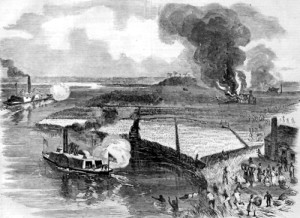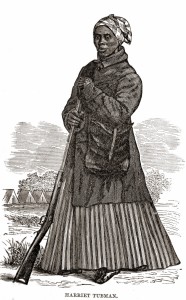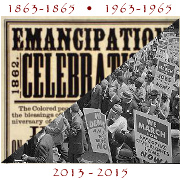Harriet Tubman and the Combahee River Raid
Posted June 2nd, 2013 by James DeWolf PerryCategory: History Tags: Black agency, Combahee River Raid, Emancipation, Harriet Tubman, Sesquicentennial of the U.S. Civil War, South Carolina, U.S. Civil War
 One hundred and fifty years ago today, Union forces led by Harriet Tubman and Colonel James Montgomery engaged in a daring and wildly successful raid up the Combahee River in South Carolina.
One hundred and fifty years ago today, Union forces led by Harriet Tubman and Colonel James Montgomery engaged in a daring and wildly successful raid up the Combahee River in South Carolina.
The Combahee River Raid crippled local Confederate infrastructure, liberated 756 enslaved blacks, and earned Tubman well-deserved accolades as the first woman in U.S. history to plan and lead a military raid.
The military operation
Tubman and Montgomery had set out the night before from Beaufort in three U.S. Navy gunboats. Montgomery commanded a detachment of soldiers from the 2nd South Carolina Volunteers, an all-black infantry regiment, while a company from the 3rd Rhode Island Heavy Artillery manned the ships’ guns. Tubman, who had scouted the area and received widespread credit for planning the raid, accompanied Montgomery and was widely seen as jointly leading the operation.
The two Union gunboats which reached the Combahee on the morning of June 2, 1863 proceeded up the river, landing troops as they went. One gunboat, the Harriet A. Weed, anchored near a plantation, while the other, the John Adams, continued upriver, eventually destroying a pontoon bridge and shelling Confederate troops.
The Commonwealth, a Boston newspaper, reported on July 10 that the expedition’s successes included “destroying millions of dollars worth of commissary stores, cotton, and lordly dwellings, and striking terror into the heart of rebeldom,” all “without losing a man or receiving a scratch.” The raid was also intended to remove mines (“torpedoes”) placed by Confederate forces along the river, and thanks to Tubman’s intelligence efforts, this, too, was accomplished.
Liberating “contraband”
The raid had one final objective: to confiscate valuable Confederate property, what Union forces still tended to refer to as “contraband.”
This goal proved rather simple for Tubman and Montgomery. As word spread of the operation moving along the river, slaves began leaving their work in the fields and rushing to the riverbanks to board the gunboats, overwhelming overseers and soldiers trying to stop them.
Tubman described the chaotic scene as follows:
I nebber see such a sight … we laughed, an’ laughed, an’ laughed. Here you’d see a woman wid a pail on her head, rice a smokin’ in it jus as she’d taken it from de fire, young one hangin’ on behind, one han’ roun’ her forehead to hold on, ‘tother han’ diggin’ into de rice-pot, eatin’ wid all its might; hold of her dress two or three more; down her back a bag wid a pig in it. One woman brought two pigs, a white one, an’ a black one; we took ’em all on board; named de white pig Beauregard, an’ de black pig Jeff Davis. Sometimes de women would come wid twins hangin’ roun’ der necks; ‘pears like I nebber see so many twins in my life; bags on der shoulders, baskets on der heads, and young ones taggin’ behin’, all loaded; pigs squealin’, chickens screamin’, young ones squallin’. ((Harriet Tubman, quoted in Sarah H. Bradford, Scenes in the Life of Harriet Tubman (Auburn, N.Y.: W. J. Moses, 1869), pp. 40-41.))
In all, Tubman reported that the raid liberated 756 enslaved blacks along the Combahee (or, perhaps more precisely, gave them the opportunity to liberate themselves), and that nearly all of the able-bodied male slaves promptly joined the Union’s colored regiments.
 The lasting impact of the raid
The lasting impact of the raid
The raid’s success, and the role of blacks in leading and conducting it, as well as the hundreds of slaves who rose up at the first sight of Union troops, made a deep impact on the Union public. At the same time, it was frightening and demoralizing for the Confederate side, all the more so because of what the raid implied about what the South’s enslaved population wanted, and was capable of.
In fact, in an effort to minimize the impact on morale and ideology, the official Confederate report was forced to lay the blame for the raid on:
a parcel of negro wretches, calling themselves soldiers, with a few degraded whites.
The broader significance of the Combahee River Raid, I think, is that it shattered two persistent myths which had long impeded the arrival of emancipation for black Americans. First, the raid demonstrated very publicly that black troops were not merely fit as laborers or cannon fodder, but were every bit as capable as their white brethren at executing complex military operations under the most challenging circumstances. Second, the raid’s success in liberating hundreds of blacks (or, in allowing them to liberate themselves) electrified the northern and southern publics and defied the Confederacy’s insistence on the quiet loyalty of its enslaved population. The raid showed convincingly that enslaved blacks were, in fact, eager for freedom and willing to rise up on a moment’s notice, if given the opportunity, and to then join Union forces in droves and fight back.
Together, these two powerful truths helped to show the necessity and rightness of emancipation, at a time when the northern public, in particular, was only beginning to wrestle with that very issue.



June 2nd, 2013 at 8:41 pm
This needs to be taught in every school as part of American history, not as Black history…
June 3rd, 2013 at 12:46 am
Agreed, Charles. So much about women in American history has been forgotten or hidden…
June 3rd, 2013 at 3:46 pm
Wish this had been in MY history class, She was one of my heroes.
July 2nd, 2013 at 11:41 am
[…] played by African Americans in and around battles such as these, in other heroic exploits such as Harriet Tubman’s Combahee River Raid, and in the other countless acts, large and small, by which African Americans fought for their own, […]